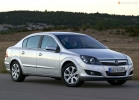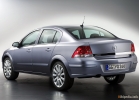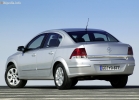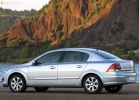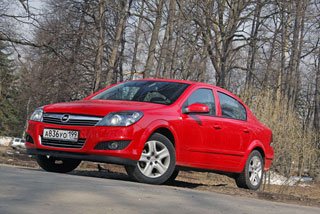Test drive Opel Astra sedan since 2007 sedan
New Opel Astra. What kind of roll?
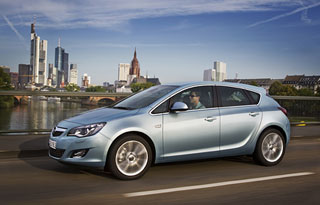 For the sixth year, the current Astra has gone how quickly time flies! It seems that there was only a premiere at the Frankfurt Motor Show in 2003. Only blossomed the full color of the modification ... Everything, friends, is time for retirement. There is something to cover so far, but powder, you feel, are empty.
For the sixth year, the current Astra has gone how quickly time flies! It seems that there was only a premiere at the Frankfurt Motor Show in 2003. Only blossomed the full color of the modification ... Everything, friends, is time for retirement. There is something to cover so far, but powder, you feel, are empty. After the premiere of the New Astra (received index I) passed a month with a little. And we are going to Frankfurt again, but do not hunt for new products, but for the first sled tests of the stars. The trump cards against the aunts of competitors in the new astra was dialing. Whatever you look at everything new. Body, appearance, richer functionality, a bunch of new chips ...
Let's start with the bones. Astra's power structure was developed by European GM designers from scratch. The new Delta II trolley is based. By the way, it already has a Chevrolet Cruze and will receive promising hybrid Opel ampera and Chevrolet Volt. In relation to the previous generation, the wheel base of the new astraa increased by 71 mm to 2685. The total length of the hatch body stretched from 4.24 to 4.4 meters. The ruts also expanded the front by 56, the rear of the 70 mm body hardness was increased by 43%, and by 10 per bending.
The chassis is simple and in many ways similar to Kruzovsky. Under the belly, you can’t find multi -links with a bunch of hinges. In front of the MacPherson with aluminum levers and hydrauli (Cruze has ordinary rubber silent blocks), assembled on the aluminum subframe. At the back of a semi-dependent suspension, a twisting H-shaped beam with a U-shaped cross-section and Watt mechanism, which is not on Chevrolet Cruze.
By the way, Watt's semi -dependent suspension and mechanism in such a configuration were marked for the first time! Symbiosis made it possible to find the desired compromise between the cost, comfort and resistance of the suspension to the forces that affect it in the transverse direction. It would be possible to reduce suppleness with an elementary increase in the rigidity of rubber -metal hinges. But in this case, alas, the level of vibrations could have suffered comfort much higher. Watt’s mechanism took part of the transverse component and slightly unloaded the silent blocks, which made it possible to make them relatively soft.
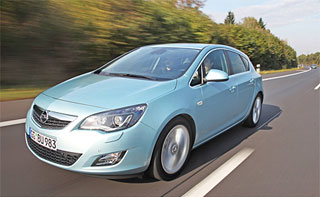 Compared to the predecessor, the new Astra on the road behaves more mature. The increase in the base and changed cinematic suspensions were beneficial. The previous model on potholes was noticeably shuddered and lost from the course. With the new chassis is much better. Astra reacts more willing to sway the steering wheel. The drive is quite transparent, minus one, the electric power is plugged with a quick steering. Little Astra better holds the trajectory, it is also more comfortable. Even in Sport mode (if the mechatron chassis), the most clamping shock absorbers, is not uncomfortable shaking. And this despite the 17- and 18-inch wheels! The brakes just do not match controllability, the pedal does not shine sensitive.
Compared to the predecessor, the new Astra on the road behaves more mature. The increase in the base and changed cinematic suspensions were beneficial. The previous model on potholes was noticeably shuddered and lost from the course. With the new chassis is much better. Astra reacts more willing to sway the steering wheel. The drive is quite transparent, minus one, the electric power is plugged with a quick steering. Little Astra better holds the trajectory, it is also more comfortable. Even in Sport mode (if the mechatron chassis), the most clamping shock absorbers, is not uncomfortable shaking. And this despite the 17- and 18-inch wheels! The brakes just do not match controllability, the pedal does not shine sensitive. The basic chassis of Astra is devoid of all sorts of tricks. In more expensive variations, there is an intelligent DMC system, which leads the characteristics of the adaptive suspension of Flexride, the steering, the stabilization system and changes the automatic transmission algorithm (if any). Active chassis is offered as an option for Enjoy, Sport and Cosmo performance with all engines, with the exception of 1.4-liter gasoline atmospheric and diesel 1.3 CDTI. Provides electronics three operating modes of Sport, Standart and Tour.
Opel dragged us to the testing ground near the town of Dudenhofen, which is not far from Frankfurt. It was there that it became clear that a civilian Astra with a custom chassis is able to satisfy the most contradictory requirements. The first part of the riding program provided for shaking in targeted areas that imitates roads with various quality coating. Second Drawing on a sports track.
With loose shock absorbers in Tour mode, Astra is comfortable and imposing. The steering wheel is light and least informative. The suspension easily swallows frightening bumps, in general, for unhurried family movement just right. But on narrow winding paths with many cool turns and studs with such settings you can’t quickly go. The body is significantly falling on its side, and if you are loaded with braking before the next turn, the car on the arc is ready to abruptly go into the skid in the inner rear wheel is almost hung out. But this, however, is only with frank provocations.
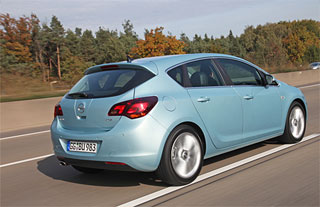 The picture is completely changing if you activate the Sport mode. Here, the suspension becomes dense rolls, no swing and graves, and the effectiveness of the electrical power appears on the steering wheel decreases more feedback.
The picture is completely changing if you activate the Sport mode. Here, the suspension becomes dense rolls, no swing and graves, and the effectiveness of the electrical power appears on the steering wheel decreases more feedback. Electronics constantly monitors the driving style and traffic conditions in particular, recognizes situations when the car accelerates, inhibits or moves in a bend, and accordingly optimizes the behavior of the car. Electronics continuously controls the damping properties of shock absorbers, changing them within a few milliseconds in accordance with the prevailing condition of the road, providing the optimal balance between controllability and comfort.
DMC can make the car safer in emergency situations. For example, if in the soft mode of Tour the driver sharply begins to maneuver in order to avoid a collision, the electronics will immediately prick, instantly increase the stiffness of shock absorbers and provide the car with maximum stability.
The system, first used in Insignia, offers additional opportunities for personification of settings in accordance with the wishes of the driver. For example, you can independently program a configuration that will be activated when choosing one of three traffic modes.
The cabin became quieter. Now the autobasm is 170, but we did not even notice. We sit, chatting with a colleague. The noise from the runaway flow is reduced to nothing. And all other sounds that penetrate the salon are more of an informational nature. The rough asphalt was replaced by smooth. After a couple of seconds, it reaches: yeah. Rustling rustled along the plastic zebra of road marking. You heard this, but as if from under the pillow.
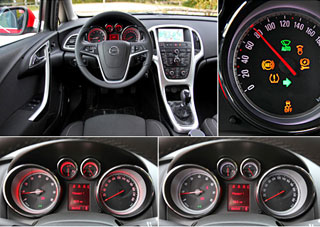 Inside, Astra largely repeats insignia. On the front panel, the abundance of keys is pleasant to press, but management requires a multilevel menu at first seems to be overloaded. Medal on the back. Emotions in the interior increased as much as the functionality became more. Previously, even a mobile phone was nowhere to put. Now a bunch of containers and boxes around the perimeter. In the central armrest there is even a secret container, and under the front seat you can order a separate box. In the door pockets, bottles of up to 1.5 liters in front and up to 1 liter behind are placed in the doorway.
Inside, Astra largely repeats insignia. On the front panel, the abundance of keys is pleasant to press, but management requires a multilevel menu at first seems to be overloaded. Medal on the back. Emotions in the interior increased as much as the functionality became more. Previously, even a mobile phone was nowhere to put. Now a bunch of containers and boxes around the perimeter. In the central armrest there is even a secret container, and under the front seat you can order a separate box. In the door pockets, bottles of up to 1.5 liters in front and up to 1 liter behind are placed in the doorway. An interesting thing, finishing the front panel and front doors is soft, the rear doors are trimmed with plastic texture, but for some reason, oak. Saving! The salon has become a little wider. The front seats are a miracle as convenient, you sit like a glove. No wonder the chairs received a certificate of the quality of the independent council of German experts and doctors in the field of ergonomics AGR (AKTION GESUNDER RUCKEN E.V. Movement for the health of the back).
Although the base is enlarged, the interior has not much more spacious in length, the fair part of the space ate thick backs of the front seats. The tall passengers in the Astra are not ice. The back of the rear sofa is laid out in a ratio of 2: 3. If the seats are folded, the trunk volume will increase from 370 (on the window sill) to 1235 liters. You can install the FlexFloor system in the trunk. This is essentially a folding shelf, it can occupy three levels in the trunk, thereby it provides a different loading height and divides the volume into two parts in different proportions. Flexfloor is designed to transport goods weighing up to one hundred kilograms, if necessary, the shelf must be lowered to the lowest position so that it rests on the bottom of the trunk.
Engines for the new astra provided as much as eight pieces, on average they are 12% more economical than predecessors. In the range of four gasoline (atmospheric and turbocharged 1.4 and 1.6) motors, and the same amount of diesel (1.3, 1.7 with various force and 2.0). Benzine units are traction and even at medium frequencies indulge in a good torque (weak atmospheres do not count). The diesel engines, although noisy, but bullets the aster better than gasoline collections. Boxes of five- and six-speed mechanical and six-speed hydrotransformer automatic transmission. The latter, by the way, were very pleased with the timeliness and high speed of switching.
The cost of a new astra in Germany begins at a mark of 15,900 euros. The main competitor of Volkswagen Golf is costing at least 16,650 euros. We have a start of sales of new items scheduled for the beginning of next year.
Text: Vitaly Kabyshev
Photo by the author and Opel
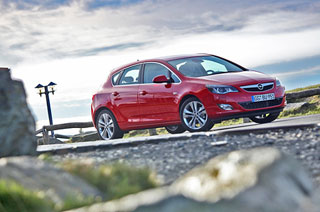
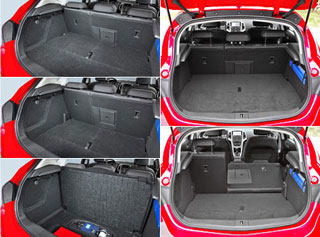
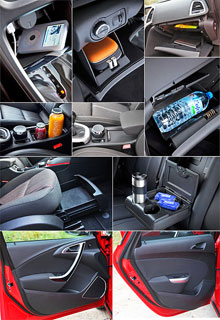
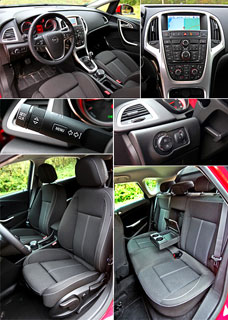
Chips
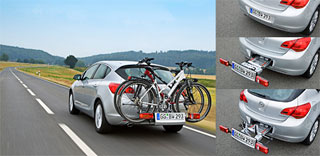
The FlexFix bicycle system, which debuted on a corsa, is a sliding structure located under the label of the trunk. It is offered as an option. If you order Flexfix, you will have to forget in the spare wheel, the place in the underground is enough only for the remote control consisting of sealant and compressor
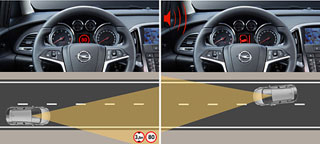
ASTRA is in vigor of many of its competitors. The machine received the Opel Eye system (developed jointly with Hella), which Insignia became the debut platform. Opelian eye, goes as an option, he observes the signs and position of the car on the roadway using a camera located in the upper part of the windshield.
The camera makes about 30 frames per second, and transfers the obtained images to the electronic brain of the system. Images are processed and compared with images introduced into memory. As soon as the electronics determined the sign, the corresponding icon will immediately be displayed on the dashboard, and so that the driver does not miss its appearance, a sound signal will be heard in the cabin. The range of the system is about a hundred meters, in most cases this is enough to take measures to action that the sign prescribes. Opel Eye tracks the position of the car on the road, observing the road marking using the same camera. As soon as the car begins to go aside monotonously or swim in the strip, the driver’s system will immediately find out to wake up
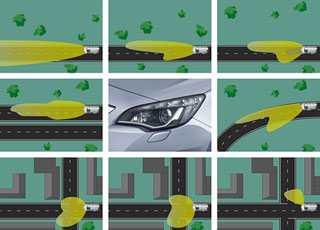
The xenon eyes of the New Astra thanks to the AFL+ system (Adaptive Front Light) received advanced accommodation capabilities. The principle of control of a light bundle is the same as that of Insignia. In total, nine operating modes are provided. The AFL+ (Adaptive Front Light) system regulates the light flow due to the original design of the xenon headlight. Optics is able to look into turns, change the brightness and geometry of the luminous border, depending on the conditions of movement. The operation of the system is based on data obtained from speed sensors, acceleration, rotation of the steering wheel, rain sensor and pair of optical sensors that are under the windshield.
The system, noticing objects and oncoming cars standing on the side of the road, draws conclusions about the environment in which the car is located. For example, in the city at low speeds, a light bundle is wider and hits nearby. The brightness is slightly reduced so as not to blind once again oncoming drivers. On high -speed tracks, the range increases in proportion to speed growth, viewing angle, light spot shape and tilt of the bundle can also change significantly depending on the situation
HISTORY
Astrology: from Kadett a to Astra I
The release of the first generation of the Opel Kadett predecessor of the current Opel Astra began at the new Opel factory in Bochum in 1962 and was timed to the 100th anniversary of the company. Experts will be indignant: what could be celebrated in 1962 if the first cars of the Opel brand appeared in 1899? That's right! Adam Opel founded his company in 1862 and was engaged in the production of sewing machines, and later bicycles. And only in 1898, the sons of Opel became interested in the cars of the German mechanics of Lutzman, however, we will return to our hero Opel Kadett a, the name of which came from the glorious ancestor of Opel Kadett, also produced in the USSR from 1946 to 1956. Under the name Moskvich-400/401
Kadett a was a two-door sedan (the four-door Kadett became only in 1973) with a 1.0-liter engine with a capacity of 40 hp. and a 4-speed gearbox. Three years later, the engine was increased to 1.1 liters, and six more years later to 1.2 liters. There was a sports modification of Kadett Rally, equipped with 1.1-liter (45 hp) and 1.9-liter (106 hp) power units
Kadett B, which was a modernized car of the previous generation, tried to sell in the United States through the Buick dealer network. But a small and uncomplicated by American standards a car of overseas motorists did not like
The basis of Kadett C, which appeared in 1973, was the international Ji-Em Platform C. In Japan this car was sold as Isuzu Gemini, in Korea as Daewoo Maepsy, in the USA as Buick-Opel. British Vauxhall Chevette and Brazilian Chevrolet Chevette were built on the same cart
The first front -wheel drive car of the Opel Kadett D brand, which appeared in 1979, brought the company the first in the history of its existence the title of a car of the year. The car was popular and for a long time leaded in sales in its class
The so -called Eshki, produced from 1984 to 1991, appeared massively in Russia in the mid -nineties along with other used foreign cars. It is about these machines that it is said: any foreign car sooner or later becomes Olesham. By the way, the Kadett production license was sold to the Korean company Daewoo. Kadett E in a modified form is produced to this day and is well known to Russians under the name Daewoo Nexia
In 1991, cars called Astra (assigned an index F) replaced the obsolete Kadett family. Note that the first -generation car offered a wide range of modifications, consisting of two hatchbacks, sedan, station wagon and its commercial three -door version for transporting goods. There were also sports modifications GT and GSI. Two years later, a four -seater convertible appeared. In 1994, the updated Astra received a driver's airbag and a hydraulic steering amplifier
The family of the Astra generation G (1997-2004) is noteworthy in that these cars were designed from scratch and, as Opel engineers stated, did not have common elements with their former generation machines. In 2005, at the Russian plant, the GM-autocrats launched the production of sedans of this generation, but Chevrolet Viva (the named named) did not enjoy mass demand and was soon removed from the assembly line
Astra H, whose premiere took place in 2003 at the Frankfurt Motor Show, fell in love with the Russians and is included in the top ten most popular foreign cars (16,644 copies were sold in the first 9 months of this year). Moreover, generation H will linger in the Russian market, due to the fact that it will be produced in our country! But not in Togliatti on the GM-Autsovaz joint venture, and not in St. Petersburg at the new General Motors enterprise, but in Kaliningrad
History: Alexey Kovanov
Photo: Vitaly Kabyshev and Opel company
A source: Auto.mail.ru


